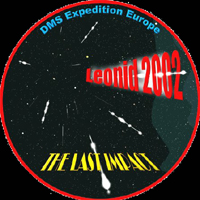|
Leonid MAC |
| home |
| View the shower |
| Mission Brief |
| Science Update |
| Media Brief |
| links |
USA Near-real time flux measurements and video imaging will be performed from Mount Lemmon Observatory in Arizona. Located at 9200 feet altitude north of Tucson, the Mt. Lemmon Observatory site helped pioneer infrared astronomy beginning in the 1970s. Astronomers from the Aerospace Corp and the Universities of Arizona, Minnesota, Wyoming, Rochester, Cornell, and Boston Univ. still use the 1.5-meter class telescopes for astronomical research. Mt. Lemmon also hosts the international Astronomy Camps for public involvement in astronomy and for teenage student research projects using several 12 to 61-inch telescopes and modern instrumentation. SPAIN The center for astrobiology in Torrejon, Spain, will host the Leonid MAC mission and will provide coordination among the various Leonid observing efforts conducted from Spain within the scope of the Leonid MAC effort. Points of contact for CAB are Capt. Rafael Gomez-Blanco and Dr. Franck Selsis. Those observing efforts include the following. The Spanish Photographic Meteor Network in collaboration with the Dutch Meteor Society will set up an intensive network of photographic stations in Andalucia . The spanish groups at ground are coordinated by Josep Trigo-Rodriguez (the University Jaume I of Castellon), Dr. Alberto Castro-Tirado (Instituto de Astrofisica de Andalucia/INTA/CSIC) and Dr. Jose L. Ortiz (Instituto de Astrof˙ŭsica de Andalucia/CSIC). The spanish network includes photographic and CCD stations in Huelva, Sevilla, M˙ŭlaga and Granada. The Serrania of Huelva station will operate Dutch Meteor Society provided photographic camera batteries together with the CCD˙ŭlarge field˙ŭcameras of the El Arenosillo Observatory (INTA/LAEFF) directed by Dr. Alberto Castro-Tirado (CSIC). Some of these CCD cameras will be adapted to obtain high resolution spectra.˙ŭ˙ŭ Dr. Jose Luis Ortiz (Instituto Astrof˙ŭsica Andalucia-CSIC) will use similar techniques from the Astronomical Institute in Granada. Additionally members of the Malaga astronomical association participate from the Sierra of Malaga under potentially excellent sky conditions.
Submm measurments will be attempted at the Caltech Submm Observatory (CSO) in Hawaii, at the KOSMA 3m submillimeter telescope in Switzerland, and at the Institut de RadioAstronomie Millimetrique (IRAM) in France, in a project coordinated by Didier Despois of the University of Bordeaux. Observations are coordinated with the ASUR deployment on the Leonid MAC mission. Detlef Koschny and colleages of the ESA/RSS Meteor Research Group at ESTEC will observe from locations in Spain as well, and support the Bordeaux sub-mm experiment at the Institut de RadioAstronomie Millimetrique (IRAM) in France. |






 The Dutch Meteor Society groups are coordinated by
Hans Betlem and
Casper ter Kuile.
The Dutch teams have stations at Castillejar, Galera, Otura and Calar Alto Observatory, where
visual observers, photographic camera platforms and intensified video systems will be deployed. Calar Alto
Observatory is planned to be the site for this year's ground-based near-real time flux measurement team.
The network includes two stations with the possibility to be mobile by using RV's,
with participants from the Dutch Meteor Society and the Ondrejov Observatory.
More information can also be found at the main site of
the
The Dutch Meteor Society groups are coordinated by
Hans Betlem and
Casper ter Kuile.
The Dutch teams have stations at Castillejar, Galera, Otura and Calar Alto Observatory, where
visual observers, photographic camera platforms and intensified video systems will be deployed. Calar Alto
Observatory is planned to be the site for this year's ground-based near-real time flux measurement team.
The network includes two stations with the possibility to be mobile by using RV's,
with participants from the Dutch Meteor Society and the Ondrejov Observatory.
More information can also be found at the main site of
the 